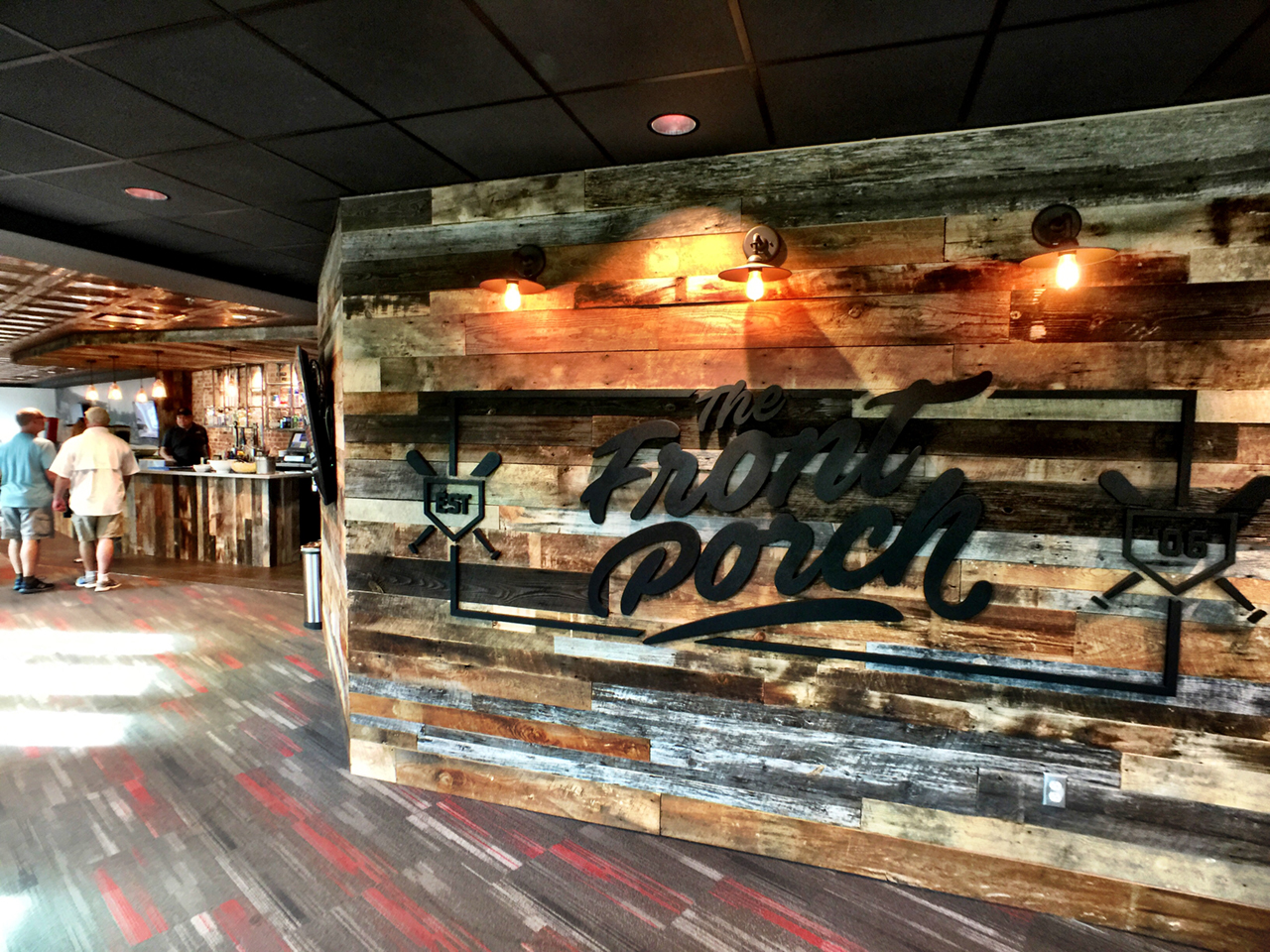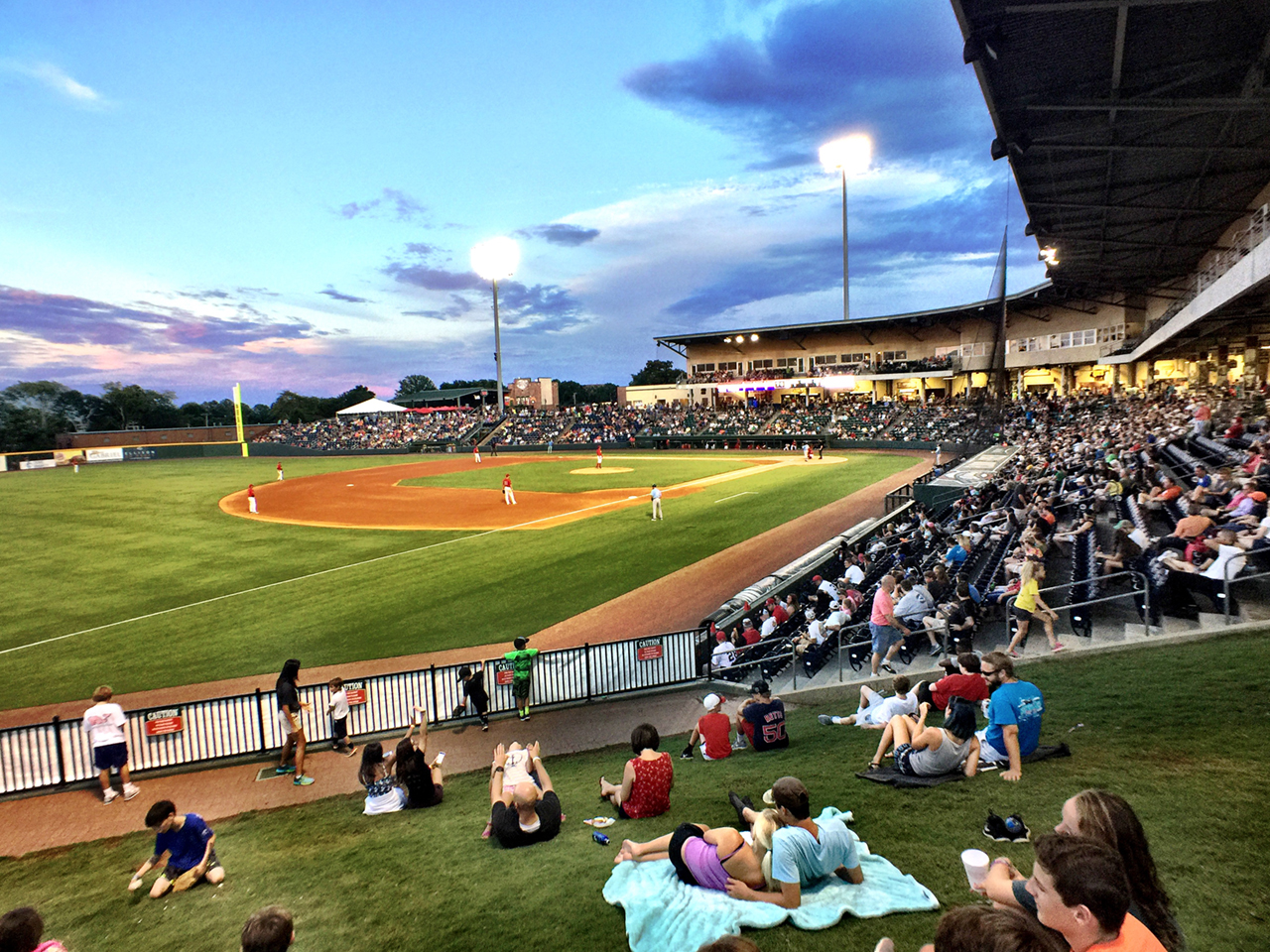Our annual Ballpark Digest Awards continue with the Greenville Drive (Low A; Sally League) and extensive upgrades to Fluor Field, earning our Best Ballpark Renovation (MiLB) recognition for 2017.
Fluor Field has always been a shining star in the ballpark world, both for its design and for its importance in leading an economic resurgence in Greenville’s West End area. It would have been easy for the team, led by Owner/President Craig Brown and GM Eric Jarinko, to maintain the status quo, but before the 2017 season the Drive embarked on a $14-million overhaul covering several areas of the ballpark. It was also an efficient job: work began immediately after the 2016 season ended and was completed in time to host the Clemson-South Carolina NCAA baseball game on March 4.
“The renovation of Fluor Field began more than two years ago with the focus being to build upon the many positive aspects of the ballpark that gave rise to the ballpark being named Ballpark of the Year in 2006, its inaugural season,” said Brown and Jarinko. “We sought to enhance the ballpark; not to change it. Fluor Field has been an economic catalyst for the Greenville Upstate for the past 11 years and these enhancements insure the ballpark will remain as an economic development catalyst for the decade ahead.
“The Champions Club presented by Hubbell Lighting, The Front Porch (season ticket holder lounge), and The Rooftop at Fluor Field, all provide high-end customer experiences at Fluor Field, with each providing their own unique experience. The Champions Club is more than 4,000 square feet of high quality event space overlooking the ballpark whereas The Rooftop at Fluor Field provides breathtaking views of the ballpark, Downtown Greenville, and the surrounding mountains. And the all-new Green Monster seats are an ode to our Major League affiliate partner, the Boston Red Sox, expanding on our own replica of historic Fenway Park—all available in Greenville, S.C.
“The $14M renovation project was completed inside of six months, which would not have been possible without a full team effort. We were able to assemble a top class design and construction team led by our original architect—the DLR Group—who along with Trehel Corporation as the general contractor, and Centennial American Properties who assisted with the project management—all were able to complete the project on time and against extremely aggressive timelines. And finally we were able to add nationally renowned design firm Advent, to bring each of our new areas to life, weaving the Greenville Drive, Fluor Field, and Greenville stories into one cohesive mosaic that depicts the role of the team and the ballpark in the wonderful Upstate community of Greenville.”
The improvements were centered in four areas: an expansion of the second level of the grandstand, the addition of seating to the top of the Green Monster, the conversion of team offices to a season-ticket-holder space, and a renovation of the team store and the front entrance. We’ll run down each.
New Green Monster Seats
Fluor Field opened with a replica Green Monster — in homage to parent Boston Red Sox — but 2017 saw the addition of two rows of seating and 100 seats a la Fenway Park. Open space in the office/condo building behind the Green Monster was converted to team offices, complete with entertainment space for group Green Monster customers, with an existing office-building elevator allowing ADA access to the new seating. These seats not only provide a great view of the action, but also of downtown Greenville and local mountains from the rear walkways and group area.
The New Front Porch
When Fluor Field opened, there was office space for 14 in the back of the grandstand, along with a lovely brick entrance. As the team’s front office grew t0 more than 30, that office space soon was inadequate. So the team’s office space was moved to the office/condo building behind the Green Monster and the prior office was converted to a space for season-ticket holders that could also host off-day events: the Front Porch. A person’s front porch is a traditional symbol of hospitality in the South, and the area’s finishes — complete with reclaimed bricks matching the rest of the ballpark design — reinforced that hospitality image.
“We wanted to make sure it looks like it’s been here forever,” Jarinko said.
An Expanded Grandstand
The grandstand was expanded down the third-base line, with the addition of The Champions Club on the second level, a covered group space below on the concourse level and new ticket-office space. The Champions Club, a large 4,000-square-foot-plus space featuring bi-fold doors, for use on both game days and for non-game day events. The Club accommodates up to 200 people for banquet seating and includes stadium seating overlooking the playing field, as well as an open floor plan that can be divided.
The extension of the grandstand was seamless: you can see the addition if you’re truly looking for it, but it’s not readily apparent to the naked eye. That keeps the feeling of Fluor Field as a timeless part of the community, perfectly fitting into the neighboring West End architecture.
A More Inviting Entrance
With the addition of new ticket-office space in the grandstand, the team store was expanded, and the front entrance was overhauled with new signage. Though the rest of the ballpark features plenty of brickwork, the team store is authentically old: it’s the second oldest firehouse in South Carolina, complete with a fire pole still installed.
There were also some other smaller changes to the ballpark as part of this project: the Dugout Club, located down the first-base line, was overhauled with a bench removed and new seating installed. (Fans, as it turns out, don’t really like sitting on a dugout bench for nine innings.) There were several upgrades to the ballpark in recent years, including a high-definition videoboard in 2016, as well as an all-new audio system, with 84 additional directional speakers installed. And finally, the 500 Club received several upgrades prior to the start of the 2016 season, which included an extension to the existing roof, a louver enclosing system on two of the sides, all-new graphics, lighting, signage, and a new naming rights partner with The Iron Yard
In Conclusion
Regular Ballpark Digest readers know that it takes a lot of work for a ballpark operator to achieve continued success. Fluor Field is in a constant state of improvement — a great example for the rest of the industry. While the Drive management always has something new on tap, the 2017 improvements really raise things to a new level when it comes to a great game-day experience. For that reason, the 2017 improvements to Fluor Field make it our choice for Best Ballpark Renovation (MiLB).
2017 Ballpark Digest Award Winners
Broadcasters: Howard Kellman and Mick Gillespie
Past Ballpark Digest Renovation of the Year winners:
2016 Renovation of the Year: The Outfield Apartments, Lansing Lugnuts
2015 Best Major Ballpark Renovation: CenturyLink Sports Complex/Hammond Stadium
2015 Best Ballpark Renovation Award (Over $6M/Under $20M): AutoZone Park
2015 Best Ballpark Renovation Award (Under $6M): Dr Pepper Ballpark
2014 Best Ballpark Renovation Over $2M: Durham Bulls Athletic Park
2014 Best Ballpark Renovation Under $2M: Simmons Field
2013 Best Ballpark Renovation Under $1M: Centennial Field, Modern Woodmen Park
2013 Best Ballpark Renovation Over $1M LECOM Park (McKechnie Field)
2012 Ballpark Renovation of the Year: Four Winds Field (Coveleski Stadium)
2011 Ballpark Renovation of the Year (Over $10M): Cheney Stadium
2011 Ballpark Renovation of the Year (Under $10M): Warner Park
2010 Ballpark Renovation of the Year: Metro Bank Park









